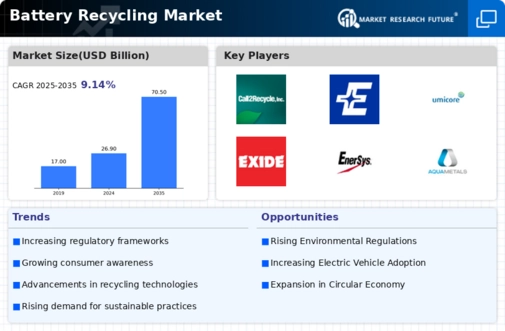Top Industry Leaders in the Battery Recycling Market

*Disclaimer: List of key companies in no particular order
The battery recycling market is undergoing unprecedented growth, driven by the surging demand for electric vehicles (EVs) and the stringent environmental regulations surrounding battery disposal. This expansion has led to a diverse array of participants, each striving to secure their share of the burgeoning market. Understanding the competitive landscape is imperative for businesses operating in this sector, enabling them to discern opportunities, assess threats, and devise effective strategies.
Key Market Players and Their Approaches:
-
Redwood Materials: A US-based company founded by Tesla co-founder JB Straubel, Redwood Materials focuses on closed-loop recycling of lithium-ion batteries. Their strategy hinges on technological innovation, collaboration with leading automakers, and establishing secure long-term supply chains. -
American Manganese: This Canadian company is developing patented hydrometallurgical processes for recycling various battery types. Their strategy revolves around cost-effectiveness, environmental sustainability, and expanding their global footprint. -
Glencore: A multinational mining and commodities giant, Glencore is making strides in battery recycling through strategic acquisitions and partnerships. Their approach leverages existing infrastructure and expertise in metals processing, with an eye on large-scale operations.
-
Li-Cycle: A North American company specializing in lithium-ion battery recycling using a safe and efficient hydrometallurgical process. Li-Cycle's strategy emphasizes rapid expansion, establishing new facilities across the continent, and fostering partnerships with battery manufacturers. -
American Battery Metals Corporation: This US-based company concentrates on recycling black mass, a byproduct of lithium-ion battery production. Their strategy prioritizes strategic partnerships with battery manufacturers and the development of proprietary processing technologies. -
Talon Metals: A Canadian mining company, Talon Metals, is exploring a nickel-cobalt project with a focus on integrated battery recycling solutions. Their strategy integrates resource exploration with recycling capabilities, aspiring for a vertically integrated business model.
Factors Influencing Market Share Analysis:
-
Technology: The efficiency, environmental impact, and scalability of the recycling technology employed play a pivotal role in determining market share. -
Capacity: The capability to process large volumes of batteries efficiently and economically is essential for capturing a significant market share. -
Geographic Reach: Presence in key regions with high EV adoption and robust battery recycling regulations provides a competitive advantage. -
Partnerships and Collaborations: Collaborations with automakers, battery manufacturers, and waste management companies can secure valuable feedstock and market access. -
Regulatory Compliance: Adherence to environmental regulations and responsible sourcing practices is crucial for maintaining market share and reputation.
New and Emerging Trends:
-
Closed-loop recycling: This approach seeks to recycle all materials within a battery back into new batteries, minimizing waste and environmental impact. -
Direct recycling: Direct recycling technology focuses on extracting valuable metals directly from black mass, simplifying the process and reducing costs. -
Integration with mining: Mining companies are exploring the integration of battery recycling into their operations, securing access to critical raw materials. -
Blockchain technology: Blockchain is being explored to track battery materials throughout their life cycle, ensuring transparency and ethical sourcing. -
Artificial Intelligence (AI) and Machine Learning (ML): AI and ML are being applied to optimize recycling processes, improve efficiency, and predict battery performance.
Overall Competitive Scenario: The battery recycling market is marked by intense competition, with both established and emerging players vying for dominance. Success is driven by technological innovation, strategic partnerships, and geographical expansion. Companies must adopt a forward-thinking approach, investing in research and development, embracing new technologies, and building strong relationships with key stakeholders to navigate this dynamic and rapidly evolving landscape.
Additional Considerations:
-
Government Policies and Incentives: Supportive government policies and financial incentives can significantly boost the battery recycling market and influence competition. -
Consumer Awareness: Increasing consumer awareness about the importance of battery recycling can drive demand for recycled materials and environmentally responsible solutions. -
Sustainability Concerns: The environmental impact of battery recycling processes is a crucial factor, and companies need to demonstrate their commitment to sustainable practices.
Market Developments and Latest Updates:
TES-AMM Singapore Pte Ltd: Established a joint venture with Glencore to build a battery recycling facility in Singapore (Aug 2023, TES-AMM press release).
GEM Co., Ltd.: Achieved commercial-scale production of cobalt and nickel from recycled lithium-ion batteries in China (Oct 2023, GEM Co. press release).
ECOBAT Logistics: Acquired European Metal Recyclers, expanding its battery recycling operations in the UK (Sep 2023, ECOBAT press release).
EnerSys: Partnered with Redwood Materials to recycle lead-acid batteries from its Motive Power division (Aug 2023, EnerSys press release).
Exide Technologies: Launched a lithium-ion battery recycling pilot program in North America (Sep 2023, Exide press release).

